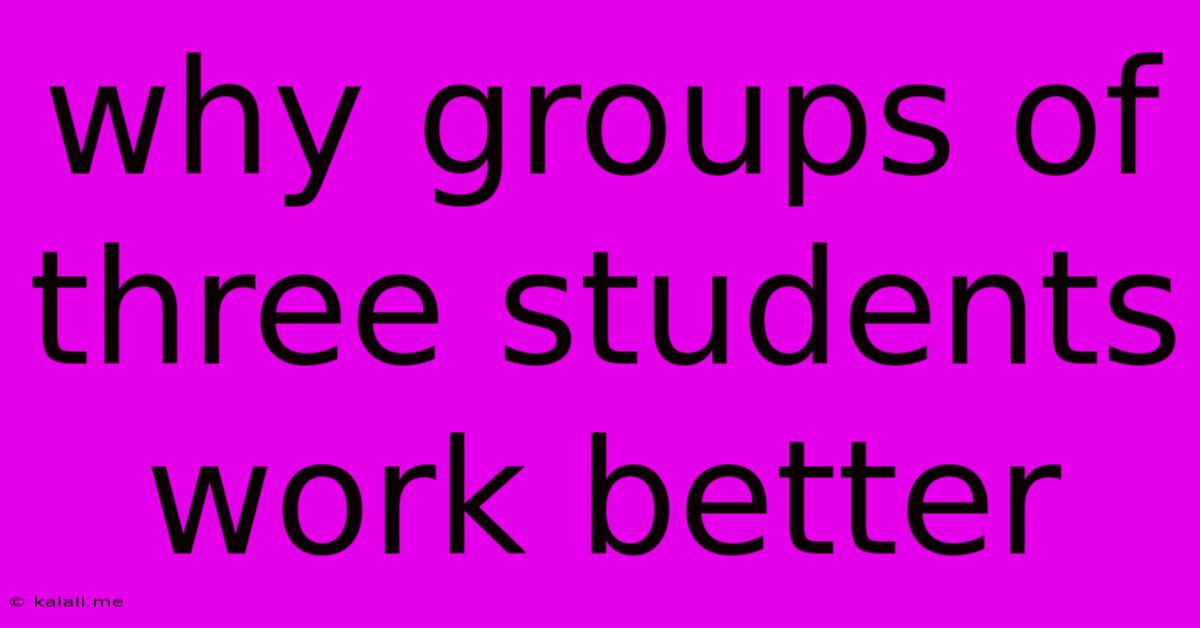Why Groups Of Three Students Work Better
Kalali
Jun 07, 2025 · 3 min read

Table of Contents
Why Groups of Three Students Work Better: The Magic Number for Collaboration
Meta Description: Discover the surprising benefits of three-student groups for collaborative learning. We explore why this number often outperforms larger or smaller teams, leading to improved project outcomes and individual student growth.
The optimal group size for student projects is a subject of ongoing debate. While some advocate for the simplicity of pairs, others suggest the diverse perspectives of larger teams. However, emerging research and practical experience strongly suggest that groups of three students often represent the sweet spot for effective collaboration. This article will explore the reasons why this magic number consistently delivers superior results.
The Goldilocks Zone of Collaboration: Not Too Few, Not Too Many
Smaller groups, particularly pairs, can suffer from several drawbacks. If one student lacks motivation or expertise, the entire project can be jeopardized. The workload can also feel disproportionately heavy, leading to burnout and resentment. Conversely, larger groups often face challenges with coordination, communication, and individual accountability. Free-riders can emerge, and decision-making processes can become bogged down.
A group of three, however, strikes a compelling balance. It offers enough diversity of thought and skill to tackle complex tasks effectively, while maintaining a manageable level of communication and individual responsibility. This "Goldilocks zone" fosters a dynamic environment where each student plays a crucial role.
Enhanced Communication and Collaboration
Three-student groups facilitate more robust communication. Discussions are less likely to be dominated by a single personality, and each individual has a greater opportunity to share their ideas and perspectives. The dynamic interplay between three minds often leads to more creative problem-solving and innovative solutions. Furthermore, with fewer participants, discussions are generally more focused and productive, preventing the common issues of larger groups where tangents and digressions can derail the project.
Improved Individual Accountability and Productivity
In smaller groups, individual contributions are more easily identifiable. This enhanced accountability motivates students to participate actively and shoulder their fair share of the workload. Free-riding is less likely to occur, as the absence of a single person's contribution would be more noticeable and impactful. The shared responsibility also promotes time management skills and efficient task delegation. Students learn to balance their individual contributions with the overall project goals, crucial skills for future professional collaborations.
Diverse Perspectives and Skill Sets
Three individuals are statistically more likely to possess a broader range of skills and perspectives than two. This diversity is invaluable for brainstorming, idea generation, and tackling various aspects of a project. One student might excel in research, another in presentation skills, and the third in technical expertise. This natural division of labor leads to greater efficiency and a higher quality final product. This also exposes students to different working styles and approaches, enriching their learning experience.
Conclusion: The Power of Three in Collaborative Learning
In conclusion, groups of three students frequently prove to be the optimal size for collaborative projects. The balanced combination of individual accountability, enhanced communication, diverse perspectives, and manageable workload contributes to improved project outcomes and fosters crucial skills for future academic and professional success. While the ideal group size can vary depending on the project’s complexity and the students' individual characteristics, the advantages of the "power of three" are undeniable and deserve serious consideration.
Latest Posts
Latest Posts
-
Kitchen Sink Drain Rough In Height
Jun 07, 2025
-
Meaning Of Stay In Your Lane
Jun 07, 2025
-
What Does Bible Say About Premarital Sex
Jun 07, 2025
-
Do You Need Specific Rims To Make Your Bike Tubeless
Jun 07, 2025
-
Plug Extension Cord Into Surge Protector
Jun 07, 2025
Related Post
Thank you for visiting our website which covers about Why Groups Of Three Students Work Better . We hope the information provided has been useful to you. Feel free to contact us if you have any questions or need further assistance. See you next time and don't miss to bookmark.